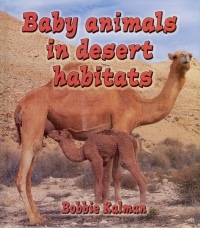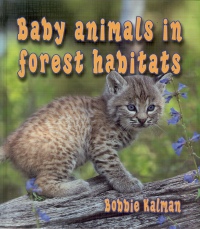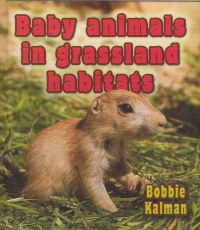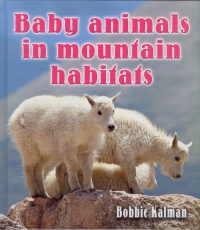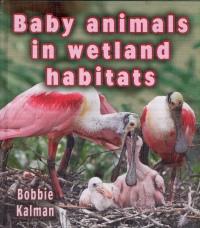| ________________
CM . . . . Volume XVII Number 41 . . . . June 24, 2011
excerpt:
"The Habitats of Baby Animals" series presents good information in a relatively simple format. Young readers will benefit from the limited quantity of text compared to photos. Concepts, such as food, homes, enemies, food chains and growing up, are explained simply with words supported by beautiful photographs. Each book includes a table of contents and an index. Although the index is titled "Words to know and Index," there is no glossary. The index lists a number of pages where information about topics, such as babies, and food, is located. This will be useful to young researchers who may be asked to find an answer to a specific factual question. Many of the index words are accompanied by a small photo which will be a visual cue for beginning readers to lead them back to a particular topic. Each book begins with an explanation of what a habitat is, including identifying living and non-living components. Each book then briefly examines the distinguishing characteristics of the particular habitat that is the focus of the book. One weakness of the series is the use of black text on dark coloured backgrounds. Sometimes white text has been used on coloured pages, but other times black text is printed, making it more difficult to read. I don't like this practice at any level but find it especially problematic in books for beginning readers. Baby Animals in Desert Habitats is probably the most difficult of the books in this series for a young reader to use independently. Beginning researchers may have some difficulty interpreting some of the information and instructions when they have to flip pages or when references are less than clear. For example, pages 12-13 show pictures of baby desert animals. The text says: "Under each animal is the name of the desert where it lives. Find the deserts on the map on pages 8-9." Some of the pictures are labelled with the name of a specific desert, such as "Kalahari Desert," that the young readers can find on the map when they flip back. Other animals have a more inclusive label, such as "North American deserts." Experienced map readers and researchers will be able to correctly interpret that "North American deserts" means that the animal lives in all three of the North American deserts marked on the map. Less experienced map readers may have trouble independently following the two steps needed to locate the correct deserts in the correct continent. Baby Animals in Forest Habitats focuses mainly on forest mammals and the role that trees play in providing food and shade to forest animals. The care that mammal mothers provide to their babies is highlighted. Baby Animals in Grassland Habitats identifies savanna and temperate grasslands. Only two pages mention savanna grasslands. The rest of the book shows plants and animals that live in temperate prairie grasslands. Baby Animals in Mountain Habitats focuses mainly on mammals that live in the mountains. Examples of herbivores, omnivores and carnivores are identified with text and photos. As with each of the books, a sample of a food chain explains the process of energy being transformed from sunlight by photosynthesis to grasses which feed the pika which are eaten by the red fox. Baby Animals in Ocean Habitats looks at a variety of baby mammals, fish, birds and reptiles that make their homes in cold and warm oceans. The photos show baby polar bears on the Arctic ice, colonies of penguins in Antarctica, and baby turtles hatching out of the sand. Baby Animals in Wetland Habitats focuses on animals that live in or near water. Wading birds, alligators, and raccoons are shown in wetland habitats. Examples of warm-blooded animals and cold-blooded animals are given with a brief explanation of the difference. The books in "The Habitats of Baby Animals" have many things to recommend them. The text layout, photographs and illustrations are all colourful and attention grabbing. Although some of the books are stronger than others, these books should be popular with beginning researchers. Recommended. Suzanne Pierson is a retired teacher-librarian, currently instructing Librarianship courses at Queen's University in Kingston, ON.
To comment
on this title or this review, send mail to cm@umanitoba.ca.
Copyright © the Manitoba Library Association. Reproduction for personal
use is permitted only if this copyright notice is maintained. Any
other reproduction is prohibited without permission.
NEXT REVIEW |
TABLE OF CONTENTS FOR THIS ISSUE
- June 24, 2011.
AUTHORS |
TITLES |
MEDIA REVIEWS |
PROFILES |
BACK ISSUES |
SEARCH |
CMARCHIVE |
HOME |
